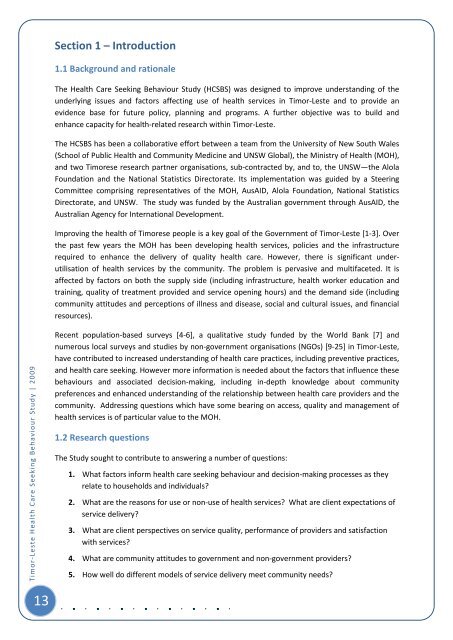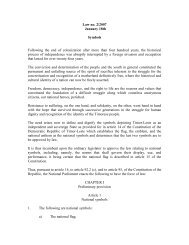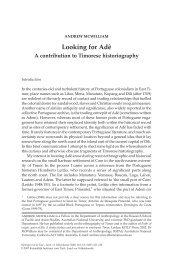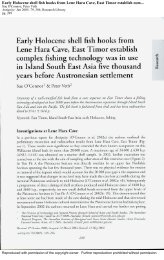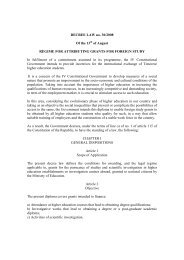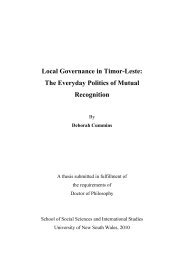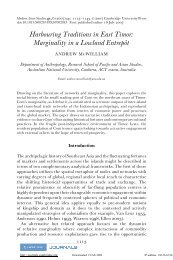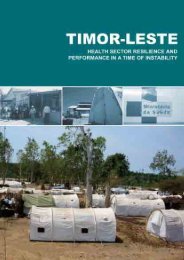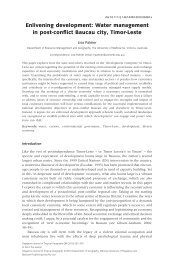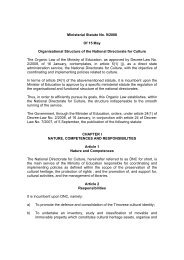Timor-Leste Health Care Seeking Behaviour Study - Secretaria de ...
Timor-Leste Health Care Seeking Behaviour Study - Secretaria de ...
Timor-Leste Health Care Seeking Behaviour Study - Secretaria de ...
- No tags were found...
Create successful ePaper yourself
Turn your PDF publications into a flip-book with our unique Google optimized e-Paper software.
Section 1 – Introduction1.1 Background and rationaleThe <strong>Health</strong> <strong>Care</strong> <strong>Seeking</strong> <strong>Behaviour</strong> <strong>Study</strong> (HCSBS) was <strong>de</strong>signed to improve un<strong>de</strong>rstanding of theun<strong>de</strong>rlying issues and factors affecting use of health services in <strong>Timor</strong>-<strong>Leste</strong> and to provi<strong>de</strong> anevi<strong>de</strong>nce base for future policy, planning and programs. A further objective was to build an<strong>de</strong>nhance capacity for health-related research within <strong>Timor</strong>-<strong>Leste</strong>.The HCSBS has been a collaborative effort between a team from the University of New South Wales(School of Public <strong>Health</strong> and Community Medicine and UNSW Global), the Ministry of <strong>Health</strong> (MOH),and two <strong>Timor</strong>ese research partner organisations, sub-contracted by, and to, the UNSW—the AlolaFoundation and the National Statistics Directorate. Its implementation was gui<strong>de</strong>d by a SteeringCommittee comprising representatives of the MOH, AusAID, Alola Foundation, National StatisticsDirectorate, and UNSW. The study was fun<strong>de</strong>d by the Australian government through AusAID, theAustralian Agency for International Development.Improving the health of <strong>Timor</strong>ese people is a key goal of the Government of <strong>Timor</strong>-<strong>Leste</strong> [1-3]. Overthe past few years the MOH has been <strong>de</strong>veloping health services, policies and the infrastructurerequired to enhance the <strong>de</strong>livery of quality health care. However, there is significant un<strong>de</strong>rutilisationof health services by the community. The problem is pervasive and multifaceted. It isaffected by factors on both the supply si<strong>de</strong> (including infrastructure, health worker education andtraining, quality of treatment provi<strong>de</strong>d and service opening hours) and the <strong>de</strong>mand si<strong>de</strong> (includingcommunity attitu<strong>de</strong>s and perceptions of illness and disease, social and cultural issues, and financialresources).<strong>Timor</strong>-<strong>Leste</strong> <strong>Health</strong> <strong>Care</strong> <strong>Seeking</strong> <strong>Behaviour</strong> <strong>Study</strong> | 2009Recent population-based surveys [4-6], a qualitative study fun<strong>de</strong>d by the World Bank [7] andnumerous local surveys and studies by non-government organisations (NGOs) [9-25] in <strong>Timor</strong>-<strong>Leste</strong>,have contributed to increased un<strong>de</strong>rstanding of health care practices, including preventive practices,and health care seeking. However more information is nee<strong>de</strong>d about the factors that influence thesebehaviours and associated <strong>de</strong>cision-making, including in-<strong>de</strong>pth knowledge about communitypreferences and enhanced un<strong>de</strong>rstanding of the relationship between health care provi<strong>de</strong>rs and thecommunity. Addressing questions which have some bearing on access, quality and management ofhealth services is of particular value to the MOH.1.2 Research questionsThe <strong>Study</strong> sought to contribute to answering a number of questions:1. What factors inform health care seeking behaviour and <strong>de</strong>cision-making processes as theyrelate to households and individuals?2. What are the reasons for use or non-use of health services? What are client expectations ofservice <strong>de</strong>livery?3. What are client perspectives on service quality, performance of provi<strong>de</strong>rs and satisfactionwith services?4. What are community attitu<strong>de</strong>s to government and non-government provi<strong>de</strong>rs?5. How well do different mo<strong>de</strong>ls of service <strong>de</strong>livery meet community needs?13


